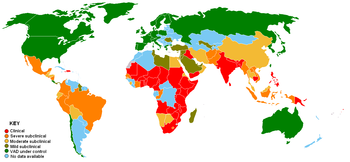
Clinical Severe subclinical Moderate subclinical | Mild subclinical VAD under control No data available |
Vitamin A deficiency (VAD) or hypovitaminosis A is a lack of vitamin A in blood and tissues.[1] It is common in poorer countries, especially among children and women of reproductive age, but is rarely seen in more developed countries.[1] Nyctalopia (night blindness) is one of the first signs of VAD, as the vitamin has a major role in phototransduction;[1] but it is also the first symptom that is reversed when vitamin A is consumed again. Xerophthalmia, keratomalacia, and complete blindness can follow if the deficiency is more severe.[1]
Vitamin A deficiency is the world's leading cause of preventable childhood blindness,[1] and is critical to achieving Millennium Development Goal 4 to reduce child mortality. About 250,000 to 500,000 malnourished children in the developing world go blind each year from a deficiency of vitamin A, around half of whom die within a year of becoming blind.[2] The United Nations Special Session on Children in 2002 set a goal of the elimination of VAD by 2010.[3]
The prevalence of night blindness due to VAD is also high among pregnant women in many developing countries. VAD also contributes to maternal mortality and other poor outcomes in pregnancy and lactation.[4][5][6][7]
VAD also diminishes the ability to fight infections.[1] In countries where children are not immunized, infectious diseases such as measles have higher fatality rates.[1] As elucidated by Alfred Sommer, even mild, subclinical deficiency can also be a problem, as it may increase children's risk of developing respiratory and diarrheal infections, decrease growth rate, slow bone development, and decrease likelihood of survival from serious illness.[6]
VAD is estimated to affect about one-third of children under the age of five around the world.[8] It is estimated to claim the lives of 670,000 children under five annually.[9] Around 250,000–500,000 children in developing countries become blind each year owing to VAD, with the highest prevalence in Southeast Asia and Africa. According to the World Health Organization (WHO), VAD is under control in the United States, but in developing countries, VAD is a significant concern. Globally, 65% of all children aged 6 to 59 months received two doses of vitamin A in 2013, fully protecting them against VAD (80% in the least developed countries).[10]
- ^ a b c d e f g "Vitamin A". Micronutrient Information Center, Linus Pauling Institute, Oregon State University, Corvallis. January 2015. Archived from the original on 27 April 2021. Retrieved 1 November 2019.
- ^ Cite error: The named reference
who98was invoked but never defined (see the help page). - ^ "In Preventing Vitamin A Deficiency, a Little Friendly Bacteria Might Go a Long Way". Rutgers Today. 19 December 2011. Retrieved 27 October 2019.
- ^ "WHO Vitamin A deficiency | Micronutrient deficiencies". Archived from the original on 16 August 2019. Retrieved 3 March 2008.
- ^ Latham, Michael E. (1997). Human Nutrition in the Developing World (Fao Food and Nutrition Paper). Food & Agriculture Organization of the United. ISBN 92-5-103818-X.
- ^ a b Sommer, Alfred (1995). Vitamin a Deficiency and Its Consequences: A Field Guide to Detection and Control. Geneva: World Health Organization. ISBN 92-4-154478-3.
- ^ "A world fit for children" (PDF). Archived (PDF) from the original on 12 October 2017. Retrieved 3 March 2008.
- ^ World Health Organization, Global prevalence of vitamin A deficiency in populations at risk 1995–2005, WHO global database on vitamin A deficiency.
- ^ Black RE et al., Maternal and child undernutrition: global and regional exposures and health consequences, The Lancet, 2008, 371(9608), p. 253.
- ^ "Vitamin A Deficiency and Supplementation UNICEF Data". Archived from the original on 11 September 2016. Retrieved 7 April 2015.